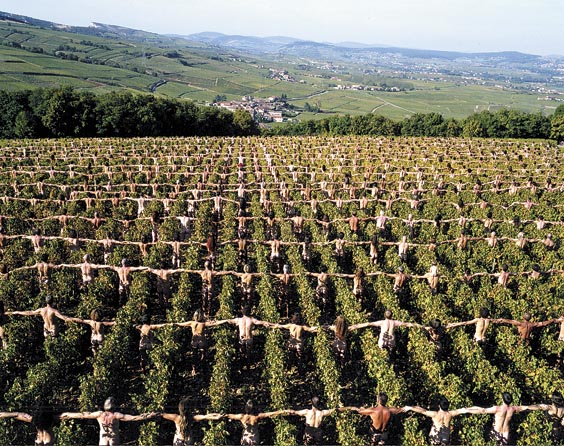By Tod Westlake
If you've seen a photograph of one of Spencer Tunick's installations, there's a good chance that you'll remember it. Tunick has become internationally renowned for photos of people — sometimes a few, sometimes several thousand — sans clothing, at various landmarks and other places of interest. He was recently in the news for a series of installations he created at the Sydney Opera House in Australia.
But you probably didn't know that Tunick is locally born and raised, and that he continues to make the Hudson Valley his home. In fact, Tunick spent a significant portion of his youth just a short distance from the Village of Wurtsboro, where his grandmother operated a popular dress shop.
"My grandmother is Helen Morrell, and she used to have this vacation house, like a hunting lodge, on Masten Lake," Tunick says. "I've been coming up here my whole life."
It was sometime in the 1950s that Helen opened the Helen Morrell Fashion Boutique. As it turns out, the shop is still in operation, selling eveningwear, jewelry, and other clothing for women. Tunick's grandfather, Leo, was a Sullivan County deputy sheriff who for a time played baseball in the New York Giants farm system. He and Helen eventually settled in Masten Lake after Leo's minor league career appeared to be going nowhere.
Tunick himself also spent time working in the area. When he was starting his photography career, he was able to support himself by working for his father on weekends here in the Catskills. His dad owned a keychain photo-viewer franchise that operated out of the Brown's Hotel in Loch Sheldrake, and Spencer for a time was an integral part of the business. He would photograph the guests decked out in their evening regalia, then rush off to Kerhonkson to develop the film before hurrying back to the hotel to insert the slides into the viewer. Then, at breakfast at 7 a.m., he would sell the pictures to the guests as a memento of their vacation.
"I lost my weekends, but I made enough money so that I didn't have to work a regular job during the week," he says.
This arrangement allowed him to spend the workweek pursuing his art, which was initially photographs of people who lived in the area. Then he applied to the International Center of Photography in the city, which was when he began to get into the New York arts scene.

A layer cake made of concrete and human beings? Tunick's medium is human beings. But his canvas ranges from industrial settings, to the more natural. Here he photographs a group of people in Burgundy, France. Photo courtesy of Spencer Tunick
|
"I started shooting on the weekends in the East Village and the financial district," he says about this period in which he lived in Alphabet City in a "C" Street apartment.
It was during this time, 1993-94, when he became interested in performance and installation art, and began searching for a method to incorporate this with his photography.
"I began thinking, 'How can I change a photograph to make a document of some action, or performance-oriented action; how can I do this with photography?'" he says.
Then, in 1994, he decided to pose and photograph 28 nude people in front of the United Nations Building in midtown.
"It all started there, moving my work from just photography into installation and performance photography," Tunick says.
Now he is in demand as he travels all over the world, fulfilling commissions for clients such as museums and grassroots organizations. The installations he recently did at the Sydney Opera House, for instance, were part of the Gay and Lesbian Mardi Gras celebration.
"I tried to combine the straight community with the gay and lesbian community, to come together and make an artwork together," he says.
And it's the ephemeral quality of such installations that attracts Tunick. The difficulties inherent in assembling a large group of people — who then disrobe en masse, sometimes in a very public place — mean that the moment is short lived when all the elements coalesce.
Tunick also finds interesting the juxtaposition between the organic and the mechanical, often choosing famous buildings or other unusual structures for his canvas. The material with which he works, however, remains human beings.
"People are my medium," he says.
But Tunick also enjoys working with a natural canvas. He's done a number of installations in natural settings, such as a series of photographs commissioned by the international organization Greenpeace, in which a large group of people were posed atop a glacier.
And it's clear that Tunick has an appreciation for those who are interested in his work. He says he's always looking for input from people in the community who might have ideas about good places for him to shoot one of his installations. He also says that he's happy to do portraiture for those who may be interested. In fact, you can email Spencer through his website www.spencertunick.com.
Next up for Tunick will be a series of installations in Manchester, England, a former industrial town which, much like our own area, is in the process of remaking itself as an artistic destination. He'll be busing this large group of people all over the city, taking a series of photos at eight different locations. Manchester, on a symbolic level, has elements that make it a perfect backdrop.
"I'm always interested in how nature overgrows the concrete world," he says. "Like how a mushroom grows through a crack in the pavement. My work touches upon that battle, or that harmony, sometimes."
Tunick says that the human body acts a kind of stand-in for nature, like the mysterious mushroom that appears in an unlikely spot.
"I like the idea of the body representing nature," he says. "There is a subversive quality when nature overgrows or overwhelms the past."
[ Rate Card ] [ Advertisers ] [ Contributors ] [ info@gunkguide.com ] [ home ]